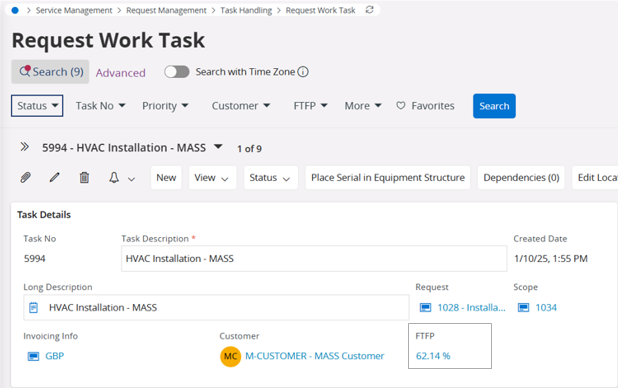About First Time Fix Prediction
The description of First Time Fix Prediction is divided into the following sections:
- What is First Time Fix Prediction?
- Model Configuration and Usage
- AI Model Identifiers
- Data Considered for Prediction
- Processing Example for First Time Fix Prediction
- Token Consumption
- Prerequisites
- Benefits
- Batch Processing
- Limitations
What is First Time Fix Prediction?
First-Time Fix Prediction uses AI to predict whether a request work task will be resolved during the initial visit. It supports service planning by highlighting potential repeat visits before dispatch, improving efficiency, customer satisfaction, and resource allocation. This prediction model analyzes various request work attributes, such as Task Type, Part Availability, Technician Experience, and Service History, to determine the likelihood of a successful first-time resolution.
You can view predictions in the Dispatch Console, or on the individual Request Work Task. These include data visuals that show prediction trends and individual task details, enabling informed decisions to proactively manage field operations. The model produces both task-level predictions and statistical summaries to help identify factors contributing to repeat visits, as well as recommended actions to take to improve the likelihood of a first-time fix.

Model Configuration and Usage
To activate predictions, train the AI model under Solution Manager / Automation and Optimization / Machine Learning / Trainable Model. After training, set the model to Active to start using predictions. Regular retraining ensures predictions reflect the latest data.
AI Model Identifiers
- AI Model Name: FIRST_TIME_FIX_PREDICTION
- AI Model Use Case: first-time-fix-prediction
- Use Types:
- Trainable
- Batch prediction
Data Considered for Prediction
The model evaluates several key inputs, including:
- allocated_start_month
- allocated_start_day_of_week
- allocated_finish_month
- allocated_finish_day_of_week
- assignment_duration
- assignment_state
- activity_type
- task_duration
- task_priority
- request_urgency
- model_object
- task_location
- location_contact_exists
- location_availability_exists
- is_resource_available
- material_availability
- skill_match
- skill_level_match
- task_created_date
Processing Example for First Time Fix Prediction
Training Example: A historical task record includes a completed maintenance activity with specific attributes: a task duration of 8 hours, an assignment duration of 6 hours, and an allocated start on a Friday in March, finishing on Saturday. The material availability score was 10, the activity type was CLEAN, and the task had a high urgency with priority level 1. The task location was LK, and all location and resource availability flags were positive. The assigned resource was fully matched in both skill match and skill level. This task is linked to an object classified as TR1-TRANSFORMER. The record contributed to a training label indicating whether the task was resolved on the first visit. In this case, the outcome supported calculating the First Time Fix Prediction (FTFP) value used to train the model.
Prediction Example: The AI model uses the input attributes to predict the likelihood of resolving the task on the first visit. The model returns a First Time Fix Prediction (FTFP) score of 79.42%, indicating a high probability that the task will be completed successfully on the first attempt.
Token Consumption
The token consumption will occur when the model is trained, when an inference call either individually or in batch occurs, and when the recommended actions are generated. They are using the hyperlink on the predicted value on Request Work Task, and when the Generate FTFP Insights from the Dispatch Console is used.
Prerequisites
To ensure accurate and functional predictions, the following data and system conditions must be in place:
- Service Basic Data
- Request Work Task
- Enable the feature from the Service AI basic data page.
- Train the model (Note: A minimum of X records is required to initiate training).
Benefits
Using First Time Fix Prediction, you can:
- Enhance service efficiency by addressing high-risk tasks early
- Optimize technician assignment based on predicted outcomes
- Improve customer satisfaction through fewer repeat visits
- Reduce operational costs and task backlogs
Batch Processing
You can schedule prediction jobs in Database Tasks using First Time Fix Batch Prediction with custom intervals to fit your operations. The model supports batch processing and offers flexible configuration to tailor the limit of the allocated start of the Request Work Tasks considered, in addition to the Company, Service organization, and Service delivery unit applicable.
Limitations
- If the attribute is changed, it replaces the previous value. However, the new true value will not be visible unless the user recalculates.
- The algorithm only learns during training. New data added after training will not be considered until a new training is triggered and the new data is within the training range parameters.
This predictive capability equips service planners with actionable foresight, enabling you to take preventive measures and enhance your field service outcomes.